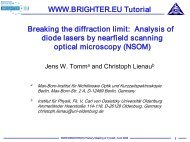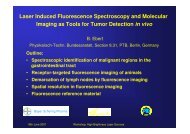BRIGHTER lasers for tomorrow's technologies - brighter.eu
BRIGHTER lasers for tomorrow's technologies - brighter.eu
BRIGHTER lasers for tomorrow's technologies - brighter.eu
You also want an ePaper? Increase the reach of your titles
YUMPU automatically turns print PDFs into web optimized ePapers that Google loves.
<strong>BRIGHTER</strong> Project Press Release – Greek Partners – English Version April 2008<br />
<strong>BRIGHTER</strong> <strong>lasers</strong> <strong>for</strong> tomorrow’s <strong>technologies</strong><br />
Scientists and engineers across Europe have joined <strong>for</strong>ces in a unique collaborative ef<strong>for</strong>t to develop a<br />
new generation of high-brightness <strong>lasers</strong> that will trans<strong>for</strong>m the fields of healthcare, communications<br />
and entertainment. The €16.25m (€9.7m of European Commission funding) project called<br />
WWW.<strong>BRIGHTER</strong>.EU, which runs until September 2009, has brought 22 of Europe’s top research<br />
teams together from industry, internationally-recognised research laboratories and leading academic<br />
institutions to achieve the next quantum leap in this multi-billion Euro field – by making <strong>lasers</strong><br />
smaller, <strong>brighter</strong>, more efficient - and cheaper!<br />
The project name stands <strong>for</strong> ‘World Wide Welfare: High-Brightness Semiconductor Lasers <strong>for</strong><br />
Generic Use’, brings together partners from a total of ten European countries and is funded by the<br />
European Commission’s In<strong>for</strong>mation Society Technologies Programme. The WWW.<strong>BRIGHTER</strong>.EU<br />
collaboration builds upon the successful WWW.BRIGHT.EU project, which was completed in 2006.<br />
Greece is represented in the <strong>BRIGHTER</strong> Consortium by the Institute of Communication and<br />
Computer Systems (ICCS) and specifically the Biomedical Optics & Applied Biophysics Laboratory.<br />
The main challenges addressed by the Consortium are to develop low-cost, high-brightness light<br />
sources <strong>for</strong> an extended range of colours (wavelengths) and to couple more light power into smaller<br />
diameter optical fibres. These improvements will, on the one hand, allow the replacement of existing<br />
cumbersome and expensive laser sources, and on the other hand facilitate the emergence of new<br />
applications. Success <strong>for</strong> the Brighter EU scientists will present opportunities <strong>for</strong> society that are<br />
simply not available today, including improved cancer treatments, new medical diagnosis techniques<br />
and state-of-the-art communications and display systems <strong>for</strong> entertainment.<br />
Project coordinator, Michel Krakowski of Alcatel-Thales III-V Lab in France, said: “There are huge<br />
markets <strong>for</strong> laser diode technology. There are a lot of applications that currently are not possible to<br />
address without high-powered diode <strong>lasers</strong>, either because of cost, colour or portability. The goal of<br />
this project is to develop new <strong>lasers</strong> with increased power and brightness. It’s about how tightly we<br />
can focus the beam.”<br />
In Greece, the Biomedical Optics & Applied Biophysics Lab was established in 1993 at the National<br />
Technical University of Athens (NTUA) and it has operated within the ICCS and the Biomedical<br />
Technology Division of the Electrical & Computers Engineering School since its <strong>for</strong>mation. It is a<br />
pioneer in the field of Biomedical Optics and it covers the following research and development areas:<br />
Biophotonics, Photodynamic Diagnosis and Therapy, 3D Optical Fluorescence Imaging.<br />
Professor Dido Yova, head of the laboratory and responsible <strong>for</strong> the Photodynamic Therapy (PDT)<br />
1
<strong>BRIGHTER</strong> Project Press Release – Greek Partners – English Version April 2008<br />
preclinical studies and Fluorescence Molecular Imaging activities within the project, said “The<br />
challenge to introduce Bright <strong>lasers</strong> in optical molecular imaging systems has led to collaboration with<br />
the partners in the field of laser material development and partners responsible <strong>for</strong> the module<br />
development. In addition within the project, there is a very close collaboration with Lund University,<br />
Sweden, in optical imaging and clinical studies. There is also close collaboration with Biolitec,<br />
Germany, in the field of Medical Laser Development. All of us we believe that the introduction of<br />
high power high brightness <strong>lasers</strong>, in PDT and Fluorescence Imaging , will open new horizons <strong>for</strong> the<br />
application of Brighter <strong>lasers</strong> in clinical therapy and diagnosis.”<br />
The unique pooling of resources in WWW.<strong>BRIGHTER</strong>.EU is stimulating new lines of research and,<br />
through the participation of major industry (who are contributing €6.5m of their own funding to the<br />
project), promises to deliver the benefits of improved technology to the European public first and<br />
much more quickly than would otherwise have been possible. This critical mass of expertise is also<br />
allowing the <strong>BRIGHTER</strong> consortium to remove barriers between disciplines and develop laser<br />
<strong>technologies</strong> <strong>for</strong> important new applications.<br />
As well as the technological developments, the project contributes to the structuring of the European<br />
Research Area. Professor Eric Larkins of the University of Nottingham said “The project is actively<br />
encouraging the increased mobility of young scientists between industry and academia to provide<br />
exciting career development opportunities. We are also developing new tutorials <strong>for</strong> training in<br />
cutting-edge <strong>technologies</strong>. These are also available through the project website to students and<br />
researchers outside the consortium.” Interested readers can find more in<strong>for</strong>mation on the <strong>BRIGHTER</strong><br />
project website at www.ist-<strong>brighter</strong>.<strong>eu</strong>, where they can also ask to be put on the mailing list to receive<br />
the biannual e-newsletter.<br />
According to the Photonics21 European Technology Plat<strong>for</strong>m, “the photonics world market in 2005<br />
amounted to more than €225 billion … and the total photonics world market is expected to triple<br />
within the next 10 years.” They also state that “the revenue of the European photonics industry grew<br />
by 12% to €49 billion in 2006 ... photonics production is now equivalent to that of microelectronics in<br />
Europe and is expected to exceed it soon.”<br />
Viviane Reding, the European Commissioner <strong>for</strong> In<strong>for</strong>mation Society and Media, said:<br />
"Photonics is driving innovation in Europe and has a strong competitive potential in areas<br />
such as communication, entertainment, healthcare and life sciences. By developing new light<br />
sources with high brightness, the <strong>BRIGHTER</strong> project is making an important contribution to<br />
the development of photonics in Europe."<br />
2
<strong>BRIGHTER</strong> Project Press Release – Greek Partners – English Version April 2008<br />
Medical applications are extremely important <strong>for</strong> European society, but the market is still fragmented<br />
and poorly connected to technology developers. One example is the minimally-invasive procedure<br />
known as photodynamic therapy or PDT. The PDT technique uses photosensitive drugs to precisely<br />
target tumours within the body – the chemotherapy-like drugs administered to the patient<br />
preferentially attach themselves to malignant tissue, causing no harm to the surrounding healthy tissue,<br />
and are only activated when illuminated by a specific colour of laser light (e.g. red). Ultimately, the<br />
winner is the patient, who will benefit from better treatment with fewer side-effects and an improved<br />
quality of life.<br />
Blue and red <strong>lasers</strong> are being developed in the <strong>BRIGHTER</strong> project <strong>for</strong> PDT applications in medicine.<br />
The blue <strong>lasers</strong> are used <strong>for</strong> fluorescence spectroscopy imaging of fluorescent markers used to locate<br />
malignant tissue. The red <strong>lasers</strong> are then used to activate the cancer drug (photosensitizer) which, like<br />
the fluorescent marker, accumulates in the tumour. In the medical field, however, technological<br />
success is no guarantee <strong>for</strong> clinical or commercial success. Thus, to ensure the clinical success, the<br />
<strong>BRIGHTER</strong> project is addressing all areas in the development chain from device and module<br />
development to systems integration and even includes clinical testing.<br />
In the first year of the project, improved red <strong>lasers</strong> have already been demonstrated and are ready <strong>for</strong><br />
incorporation into a PDT delivery system. A high-brightness blue laser source has been demonstrated<br />
by the frequency-doubling of a high-power infrared laser. (Frequency-doubling is an advanced<br />
technique that uses a special nonlinear optical crystal to convert the colour of the laser output.) The<br />
new blue laser has been incorporated into a fluorescence imaging system <strong>for</strong> looking at malignant<br />
tissue at the Lund Laser Centre and the first clinical tests have already begun.<br />
Projection display systems are a relatively new application of laser diodes with several challenges that<br />
still need to be overcome be<strong>for</strong>e such systems become portable and af<strong>for</strong>dable <strong>for</strong> everyday use. A<br />
laser display requires red, green and blue <strong>lasers</strong> to be integrated into a single module. Red and blue<br />
<strong>lasers</strong> are being developed within the project <strong>for</strong> the medical market, so that the main challenges<br />
remaining are the realisation of a high-brightness green laser diode and the development of a full<br />
system prototype. The green laser diode is a particular challenge as no semiconductor material exists<br />
that can be used to directly produce green laser light. In <strong>BRIGHTER</strong>, the frequency-doubling<br />
principle, successfully demonstrated in the realisation of the blue medical laser, is now being extended<br />
to produce this all important green laser from a high-brightness infrared device.<br />
In the communications world, near infrared <strong>lasers</strong> play a key role in helping to send digital<br />
in<strong>for</strong>mation down many hundreds of kilometres of optical fibre. The growth of the internet and the<br />
3
<strong>BRIGHTER</strong> Project Press Release – Greek Partners – English Version April 2008<br />
reduction in long distance costs are largely due to advances in erbium-doped fibre amplifiers or<br />
EDFAs, which are pumped by high-power laser diodes. According to the Photonics21 Strategic<br />
Research Agenda, data rates to the home are expected to continue to increase a hundred-fold during<br />
the next decade. This will require a further increase in the capacity of the telecommunications<br />
networks. In order to increase the network capacity, new systems such as Raman amplifiers and their<br />
associated pump <strong>lasers</strong> must be developed to serve new optical bands in the telecommunications<br />
spectrum.<br />
In the project, high-power near infrared <strong>lasers</strong> are being developed to pump both EDFA and Raman<br />
amplifiers. These <strong>lasers</strong> are also being developed <strong>for</strong> optical wireless communication systems, which<br />
allow high-speed data links between, <strong>for</strong> example, buildings on a campus or a city centre without the<br />
need <strong>for</strong> buried fibres. This technology will also have an important role in re-establishing temporary<br />
communications in disaster areas. Over the last year, researchers in <strong>BRIGHTER</strong> have produced nearinfrared<br />
devices with improved power and brightness <strong>for</strong> these communications applications. The<br />
infrared <strong>lasers</strong> that have been realised have also been shown capable of the high-speed operation<br />
necessary <strong>for</strong> optical wireless systems and also <strong>for</strong> the green display <strong>lasers</strong>.<br />
4




